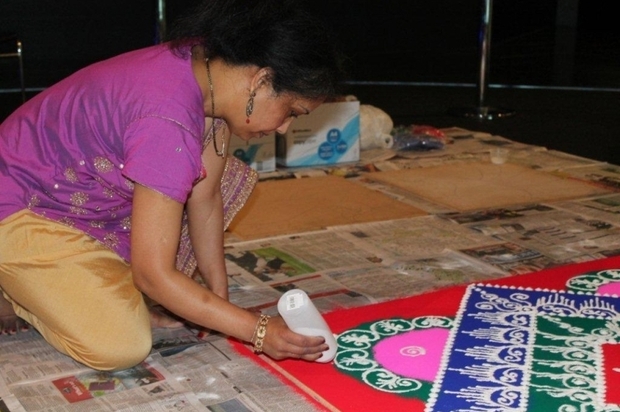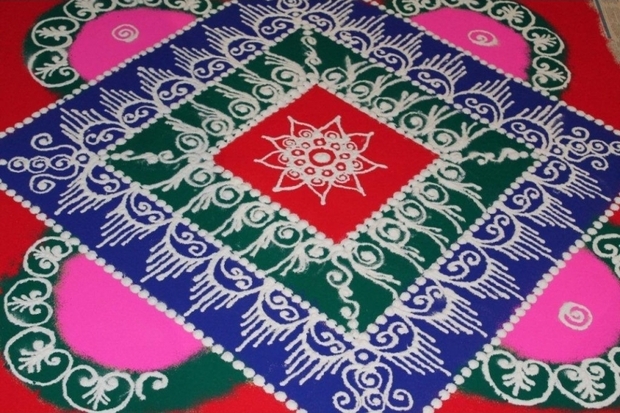
“It brings people together – Mumbai is a multi-lingual city but rangoli would bring different speakers from states around our country together in this art form.” - Jyoti Nilesh Gosavi (Rangoli Artist, Wellington)
Gallery: Artist Jyoti Nilesh Gosavi creating her work at Te Papa
Rows of Colours

The “Rows of Colours” – it’s beautiful, intricate and only lasts a day. The Hindi word 'rangoli' is made up of two words: rang - meaning “colour” and oli – meaning “rows”, the rows of colours. This ancient Hindu folk art form practiced across India uses elements of nature; sand, colourful marble powders or flower petals. The fleeting art form takes place on the floor. In the South of India Rangoli is called kolam and is created with rice flour mixed with water – to create a paste which then dries and lasts a little longer. Rangoli can be created with coloured semolina too. Not just decorative, reasons for creating rangoli are to bring good luck and prosperity during any auspicious gathering such as weddings or festivals.
Award-winning artist Jyoti Nilesh Gosavi is busy explaining her rangoli creations to onlookers at the Museum of New Zealand, Te Papa Tongawera in Wellington. Dressed in a traditional salwar kameez, Jyoti began working on her pieces at Te Papa first thing in the morning. By the time I arrive she has almost completed her largest floor piece and she is ready to take a well-deserved break.
Jyoti was sponsored by the Asia New Zealand Foundation to create rangoli inside Te Papa during the weekend celebrations of Diwali, the Festival of Lights. Diwali itself is one of the most auspicious and popular Hindu festivals, where many lamps are lit so that light conquers darkness, good conquers evil.
Jyoti explains that either geometric shapes or portraits of deities, or flower shapes make up rangoli. Teams of artists might create huge pieces together. Jyoti tells me that rangoli dates back several thousand years and is even mentioned within Hindu mythology as a practice. Rangoli art was even referenced in the epic Indian religious story of Ramayana. Rangoli is “time-bound”, created over hours or days only to be a temporary installation, to be blown away the next day and to go back to nature.
Jyoti says that the temporary nature of rangoli might bring about sadness, even from viewers, when the piece is lost so soon after completion, but it’s part of the Hindu philosophy that looks at the law of detachment and the impermanence of life.
Deep red colours like sindoor (vermilion) or bright yellow haldi (turmeric) and other natural colors can be added to the dry base material of rice flour or marble dust. Rangoli can be any size, can even be three dimensional (like a sand sculpture) and can use a wide variety of materials. It’s an inclusive and community based activity. Any one from serious artists to children can create rangoli.
For Jyoti this is a family and community tradition practiced not just at Diwali but all year around. Jyoti grew up in her birthplace Mumbai and her family regularly created rangoli with marble dust powder – the marble dust being used more prevalently by her community. Drawn to the colours and shapes Jyoti followed her mother and grandmother in this art form from the age of nine. Once she finished her artwork at home Jyoti would go and create rangoli around her neighbourhood. Jyoti took up rangoli seriously while at university and eventually went on to win first prize awards in Mumbai for her creations.
Each shape has meaning – the curved shapes inside her large centre piece, symbolise one-ness with the universe. Sanskarbharati rangoli is a geometric design, abstract and symbolic. Jyoti’s piece is made up of striking red, blue, green and pink colours, delineated by white lines.
Jyoti explains that the other type of rangoli is a kind of “portrait” rangoli, made up of recognisable deities like Lasksmi the goddess of wealth and prosperity or symbolic animals such as peacocks.
Jyoti’s teenage daughter is also very keen to follow in her mother’s footsteps as a rangoli artist and although it seemed that rangoli was more prevalently a feminine art form during her grandmother’s time, nowadays it is seriously practiced by men across India.
Jyoti herself is keen to share rangoli with people here too, and is hoping to hold workshops with in Wellington.
.jpg)

